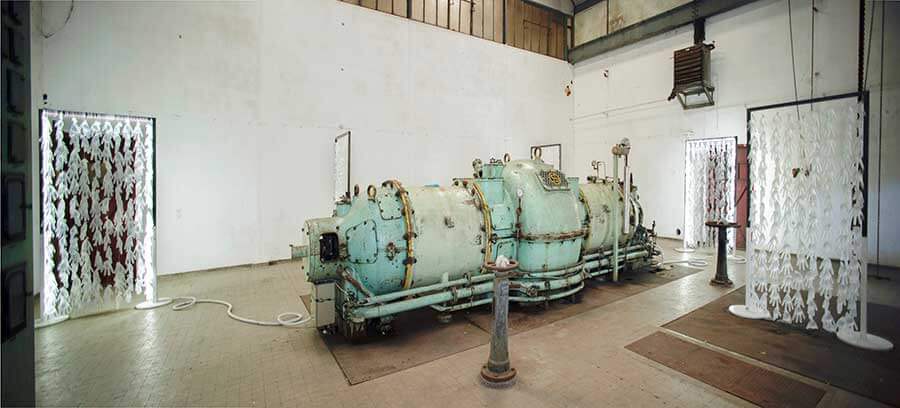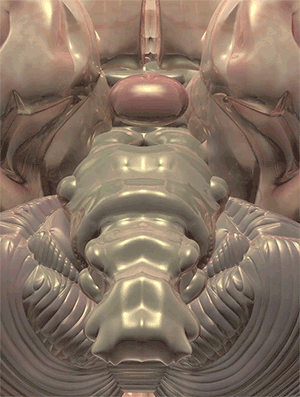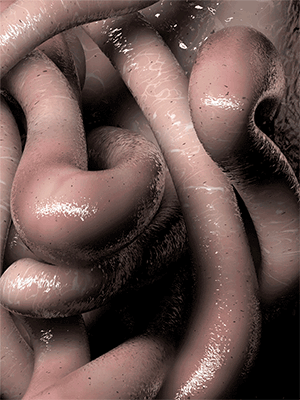Interview by Allan Gardner

Salomé Chatriot is a French-born artist and multimedia interaction designer currently living and working in Paris. Her practice is focused around the creation of spaces which intersect the physical and the digital. This often manifests through the marrying of electronic, kinetic sculptures and digital imagery. The work attempts to explore the ways in which science and technology treat the body through a means of data-oriented objectivity.
Her work rejects notions of techno-negativity instead of taking inspiration from the notion of environments in which the digital and the organic interact, often with a subtle emphasis on healing. Part of this process of healing comes through the transmission of organic materials, breathing, circulation of liquid and the processing of chemical reactions or organic data by electronic machines.
This is an essential aspect of her work, the interaction and coalescence of organic, digital, virtual, designed and natural materials moving towards a place of unity. With installations like Distal Extension (2017), Chatriot produces an interactive space in which the viewer actions the function of the sculptures through the use of their own body.
Beginning with the palm of the hand, the machines begin to move in relation to the viewer’s heartbeat. Breathing into a medical spirometer engages a chain reaction mirroring our body’s processing of oxygen – the sculptures expand and contract, shifting as the carbon dioxide we breathe out is processed.
It encourages an intimacy with the machines, engaging an essential biological function as an act of empathy as we see the sculptures empowered by our breathing.
The breath is reduced to chemicals, fuel, and data, consumed to create kinetic energy through which the work is able to communicate back a mirror of the viewer’s own biological function. It’s an exchange of information between the technological and the biological that is made possible through the sharing of material and, resultantly, the creation of a relationship between the two.
Her most recent exhibit Fragile Ecosystem in Geneva (an installation work conceived in Paris in 2018), takes on a new form as the artist’s body replaces the machine. Curated by Oil Productions, this new phase of the work further compounds the relationship between the technological and the biological.
As the artist replaces the machine, she takes on the labour. She creates an empathetic relationship between the two and gives weight to the exchange present in that relationship. It encourages a new perspective on the way we treat technology, the function of technology and its expanding role in our lives. As Chatriot hyperventilates, taking on the role, the connection is established in the environment and taken into the outside world as the performance ends.


Right: Guts, Salomé Chatriot
For those that are not familiar with your work yet, could you tell us more about your background and influences?
As an artist, my work focuses on the creation of physical and virtual spaces: I build machines and installations where electronic sculptures and digital images coexist. Fascinated by the way science treats body[ies] through data-oriented objectivity, I use potential futures and new technologies to shape a fluid, digital and precious identity. In disagreement with the techno-negative attitude, the ecosystems I am producing always bear the mark of certain healing.
The well-being I wish to transmit often involves the real-time diffusion of organic flows such as breathing, circulation of liquids and [al] chemical transformations. In my artistic creations, the process is as important as the result: I one hand, I am experimenting and manipulating physical, electronic, digital and virtual materials in the manner of a scientist, with rigour and precision. In the other, I work following my intuitions very organically: I feel like a super tech version of Dr Frankeinstein and being its creature in the meantime!
My influences are very eclectic: from classical theatre, antiquity, its myths and their contemporary interpretations, to medicine and the human body, passing by the aesthetics of machinery and industrial materials living inside in a frozen but alive nature. At different scales, they all have in common the concept of [organic] representation.
My pieces often create bridges into history, extracting classical concepts and enlighting them through the prism of technologies in order to comment on our contemporary society. Le Lamento du jardinier was a thesis I wrote following this process. I wanted to show how live streaming was closer to antique theatre than a contemporary representation and how it affects the real-life interaction between people through identification, self-exhibition, confidence and empathy.
To achieve this text, I analysed the different shifts in theatre history, from the building itself (architecture structures the representation) to the staging through the ages, slowly becoming [moving] images in 2D, 3D, or 4D. In this regard, I consider all my pieces as (immersive) images: whatever their nature: stills, sculptures or whole installations.
Furthermore, I got interested in how people construct and represent themselves through their own data. With technological advances and the reduction of their costs and size, sensors have become democratised, are now an integral part of everyone’s privacy, and became objects of fetish. I have been working on biometrical data and their extension in digital, virtual and real spaces for 3 years now. Distal Extension was my first installation that was displaying real-time body analysis and projected personal data into public space; on one hand, extending a physical shell, publicly exhibiting oneself’s intimacy on the other.
Finally, I turned my attention to seduction. Since marriage is no longer ritualised but dependent on personal will in Western cultures, seduction is on all fronts. It is sovereign: it no longer confines itself only to the loving environment. It has intruded into all spheres, economic, social, educational, and cultural. The question of the body is multiplied via all the representation platforms on which it can be registered and fragmented, whether real, digital or virtual.
Unfortunately, this is a very cold way of referring to a completely natural mechanism of living things. I try to incorporate a touch of eroticism into my work with the use of fluids or organic movements. Actually, I am fascinated by the figure of the nymphs in ancient myths; their polymorphic structure, which allows them to transform themselves with the help of nature’s elements.
One of your latest artworks is Fragile Ecosystem; what was the intellectual process behind it?
Fragile Ecosystem is a polymorphic landscape in space and time, in which the first phase was an on-site installation in the former paper mill of the Moulins de Sainte Marie in Paris. The central character of this artwork is the Machine, a gigantic turbo alternator. The various components of the installation are flooded with her vital energy.
Few screens show a living organism composed of her moving flesh, and the sculptures around her pulsate with the same intensity as her cardiac rhythm. I designed the arches to be in between medical devices, interfaces and external entities. Placed in front of the doors, they delimit the [machine] representation space and become borders.
The gloves are contact zones from physical and sensitive points of view. The water inside creates condensation on their surface due to the temperature difference from the outside: fine droplets bead at their ends. The installation is destined to be assembled, dismantled, and fragmented because, in the end, whatever its form, it retains only its primary idea: a fertile and living matrix.
Fragile Ecosystem was curated by Oil Productions, an amazing team of girls creating ethical and dissident porn. In Geneva, the machine was substituted by my own body, and the whole installation was reacting interactively to the rhythm of my breathing. The performance took place when the sun was going down, projecting its last rays onto the reflective surfaces.
It was really intense to be hyperventilating for three hours. At first, I could see time passing, then little by little. I couldn’t see anything except a few flashes of fuzzy light, the buzzing of my breath in my ears, and my body feeling restless. Meanwhile, Nora Smith was projecting live visuals on a sculpture in real time.
Analysing my reactions, she made her creations more complex when I couldn’t breathe: she maintained the fragile balance of tension within the room. Despite some dizziness, I really felt that I had reached a form of appeasement and balance during the performance, in part due to the general caring that prevailed there.
About your creative process, does your work generally involves a lot of conceptual development beforehand, or it stems more from an aesthetic need?
My work involves a lot of both conceptual and aesthetic research. Constantly archiving the visual, sonic and intellectual material I find, I re-inject it in the right way into my different ongoing artistic productions. For the time being, and not to mention my other side projects, I consider that I am running three distinct artworks at the same time: Fragile Ecosystem, Synthetic Bodies and Opéra Passiflore. Each of them conjures up notions that are intimately intertwined, like Russian dolls, which I project as extensions of their queen mother through the body representation. However, each has its own life and personal development perspectives, also linked with the co-creators I am working with.
Synthetic Bodies is an interactive performance I created with Samuel Fasse. It essentially raises the notions of intimacy, territory takeover by a moving body and the revelation of different realities through the technology activated by the gestures of three performers. We consider this project as the foundation of a long-term collaboration and will mutate into a series of exhibitions. They will begin next September with two solo /duo shows, one in London and the other in Paris.
Opéra Passiflore is a very organic machine that I constantly feed with Federico Nicolao and also takes place over the long term. We work in an autonomous but symbiotic way, him with text and non-linear narrative strategies and me with images and plastic production. This artwork is an installation accompanied by a performance in its final form but can be subdivided into small productions, publications, and residencies in its intermediate form.
As I mentioned, Fragile Ecosystem has grown up around my beloved Machine and has slowly evolved. The project will continue to expand with new presentations during the next few years. In the end, I conceive my works as “millefeuilles”. (A millefeuille is a (delicious) French pastry with several hard and soft layers, one above the other.)
From their birth, they keep growing both conceptually and esthetically: always in motion, creating circumvolutions but never erasing the first bits of the original idea. It is also a way of building a rhizomatic organization of knowledge, plastically coherent in my work, through the use I make of different network systems.
From programmable matter, 3D/4D printing and biological design, and human interaction with digital interfaces, the material seems to be more and more blending with the digital. Where do you think we are headed in terms of the new digital materialism?
My answer will seem obvious, but we are, of course, only in the early stages of digital materialism. The classic phrase that we always hear around us, outside the scientific world, “Could you believe, … years ago we would never have imagined [….]”, is representative of the considerable acceleration of contemporary progress, thanks to research and development in the field of innovation.
Over time, the number of years invoked is reduced when the following proposal becomes more and more incredible. Shifting from interfaces for the real world: Could you believe, 20 years ago, we would never have imagined live streaming on the Internet! Could you believe 15 years ago, we would never have imagined rendering real-time 3D graphics so realistic in VR! Could you believe 10 years ago, we would never have imagined 3d printing living cells! Could you believe 5 years ago, we would never have imagined editing the human genome would be possible?
The real challenge of distorting reality through new technologies is to provide access and learning for the entire population to understand them. As I told you, I don’t want to highlight the whole dystopic part related to innovations; and especially not to become a techno alarmist. However, among all the dangers of such rapid progress, inequalities will become a priority to be solved.
What’s your chief enemy of creativity?
Laziness. I have the feeling that people are not curious enough.
You couldn’t live without…
Freedom.






